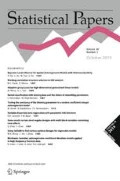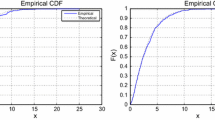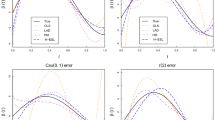Abstract
By relaxing the linearity assumption in partial functional linear regression models, we propose a varying coefficient partially functional linear regression model (VCPFLM), which includes varying coefficient regression models and functional linear regression models as its special cases. We study the problem of functional parameter estimation in a VCPFLM. The functional parameter is approximated by a polynomial spline, and the spline coefficients are estimated by the ordinary least squares method. Under some regular conditions, we obtain asymptotic properties of functional parameter estimators, including the global convergence rates and uniform convergence rates. Simulation studies are conducted to investigate the performance of the proposed methodologies.



Similar content being viewed by others
References
Aneiros-Pérez G, Vieu P (2006) Semi-functional partial linear regression. Stat Probab Lett 76:1102–1110
Aneiros-Pérez G, Vieu P (2008) Nonparametric time series prediction: a semi-functional partial linear modeling. J Multivar Anal 99:834–857
Aneiros-Pérez G, Vieu P (2011) Automatic estimation procedure in partial linear model with functional data. Stat Pap 52:751–771
Baíllo A, Grané A (2009) Local linear regression for functional predictor and scalar response. J Multivar Anal 100:102–111
Cai TT, Hall P (2006) Prediction in functional linear regression. Ann Stat 34:2159–2179
Cai Z, Fan J, Yao Q (2000) Functional-coefficient regression model for nonlinear time series. J Am Stat Assoc 95:941–956
Cardot H, Ferraty F, Sarda P (1999) Functional linear model. Stat Probab Lett 45:11–22
Cardot H, Ferraty F, Sarda P (2003) Spline estimators for the functional linear model. Stat Sin 13:571–591
Cardot H, Sarda P (2008) Varying-coefficient functional linear regression models. Commun Stat 37:3186–3203
Chen H (1991) Polynomial splines and nonparametric regression. J Nonparametric Stat 1:143–156
Chiou JM, Müller H, Wang J (2003) Functional quasi-likelihood regression models with smooth random effects. J R Stat Soc B 65:405–423
Dabo-Niang S, Guillas S (2010) Functional semiparametric partially linear model with autoregression errors. J Multivar Anal 101:307–315
de Boor C (2001) A practical guide to splines. Springer, New York
DeVore RA, Lorentz GG (1993) Constructive approximation. Springer, Berlin
Ferraty F, Vieu P (2006) Nonparametric functional data analysis. Springer, New York
Hall P, Horowitz J (2007) Methodology and convergence rates for functional linear regression. Ann Stat 35:70–91
Huang JZ, Wu CO, Zhou L (2004) Polynomial spline estimation and inference for varying coefficient model with longitudinal data. Stat Sin 14:763–788
Huang JZ, Shen H (2004) Functional coefficient regression models for non-linear time series: a polynomial spline approach. Scand J Stat 31:515–534
Lian H (2011) Functional partial linear model. J Nonparametric Stat 23:115–128
Lian H (2012) Empirical likelihood confidence intervals for nonparametric functional data analysis. J Stat Plan Inference 142:1669–1677
Müller HG, Sentürk D (2011) Functional varying coefficient models. Recent advances in functional data analysis and related topics. In: Ferraty F (ed) Contributions to statistics. Springer, Berlin Heidelbeg, pp 225–230
Newey WK (1997) Convergence rates and asymptotic normality for series estimators. J Econ 79:147–168
Ramsay J, Silverman B (2005) Functional data analysis, 2nd edn. Springer, New York
Rice JA, Silverman BW (1991) Estimating the mean and covariance structure nonparametrically when the data are curves. J R Stat Soc Ser B 53:233–243
Schumaker LL (1981) Splines function: basic theory. Wiley, New York
Stone CJ (1982) Optimal global rates of convergence for nonparametric regression. Ann Stat 10:1040–1053
Stone CJ (1985) Additive regression and other nonparametric models. Ann Stat 13:689–705
Wong H, Zhang RQ, Ip W, Li GY (2008) Functional-coefficient partially linear regression model. J Multivariate Anal 99:278–305
Wu Y, Fan J, Müller H (2010) Varying-coefficient functional linear regression. Bernoulli 16:730–758
Xue L, Yang L (2006) Additive coefficient modeling via polynomial spline. Stat Sin 16:1423–1446
Yao F, Müller HG, Wang JL (2005) Functional linear regression analysis for longitudinal data. Ann Stat 33:2873–2903
Zhang D, Lin X, Sowers M (2007) Two-stage functional mixed models for evaluating the effect of longitudinal covariate profiles on a scalar outcome. Biometrics 63:351–362
Zhou S, Shen X, Wolfe DA (1998) Local asymptotics for regression splines and confidence regions. Ann Stat 26:1760–1782
Zhou J, Chen M (2012) Spline estimators for semi-functional linear model. Stat Probab Lett 82:505–513
Acknowledgments
The authors are grateful to the Editor and two referees for their valuable suggestions that greatly improved the manuscript. The work was supported by National Nature Science Foundation of China (Grant Nos. 11225103, 11301464), Research Fund for the Doctoral Program of Higher Education of China (20115301110004) and the Scientific Research Foundation of Yunnan Provincial Department of Education (No. 2013Y360).
Author information
Authors and Affiliations
Corresponding author
Appendix: Proofs of Theorems
Appendix: Proofs of Theorems
Denote \(B_{js}=K_{jn}^{1/2}\phi _{js}\), where \(\phi _{js}\)’s are the normalized B-splines in the space \(S_{k_j,N_{jn}}\) for \(s=1,\ldots , K_{jn}\) and \(j=0,1,\ldots , p\). It follows from Theorem 4.2 of Chapter 5 in DeVore and Lorentz (1993) that for any spline function \(\sum _{s=1}^{K_{jn}} b_{js} B_{js}\), there are positive constants \(M_1\) and \(M_2\) such that
where \(|\cdot |_2\) is Euclidean norm.
Define \(\mathbf {B}=(\mathbf {X},\mathbf {Z})\), where
To prove Theorems 1 and 2, we require the following Lemmas.
Lemma 1
If Assumptions (A1)–(A6) hold, we have
Proof
For an i.i.d. random variable sequence \(\xi _1,\ldots ,\xi _n\), let \(E_n(\xi _i)=\frac{1}{n}\sum _{i=1}^n\xi _i\). By Assumptions (A2)–(A5), we have
Consequently, we only need to prove that for arbitrary given \(\eta >0\), as \(n\rightarrow \infty \), we have
If \(|(E_n\!-\!E)<X_i,a_0>^2|\!\le \! \eta ||a_0||_2^2\), \(|(E_n-E)\left\{ <X_i,a_0\!>\!a_j(U_i)Z_{ij}\right\} |\!\le \! \eta ||a_0||_2||a_j||_2\) for \(j\!=\!1,\ldots ,p\), and \(|(E_n-E)\{a_j(U_i)a_{j'}(U_i)Z_{ij}Z_{ij'}\}|\!\le \! \eta ||a_j||_2||a_{j'}||_2\) for \(j',j=1,\ldots ,p\), we obtain
Thus, we have
For \(I_1\), it follows from Lemma 5.2 of Cardot et al. (1999) that \(I_1\rightarrow 0\) as \(n\rightarrow \infty \). Following the similar argument of Lemma 1 in Huang and Shen (2004), it is easily shown that \(I_3\rightarrow 0\) as \(n\rightarrow \infty \). Consequently, we only need to prove that for \(j=1,\cdots ,p\),
Note that \(<X_i,a_0>a_j(U_i)Z_{ij}=\sum _{s_0=1}^{K_{0n}}\sum _{s_j=1}^{K_{jn}} b_{0s_0}b_{js_j}<X_i,B_{0s_0}>B_{js_j}(U_i)Z_{ij}\) for \(j=1,\ldots ,p\). Hence, if \(|(E_n-E)\{<X_i,B_{0s_0}>B_{js_j}(U_i)Z_{ij}\}|\le \eta \) for \(s_0=1,\ldots ,K_{0n}\) and \(s_j=1,\ldots ,K_{jn}\), it follows from the Cauchy-Schwarz inequality and Eq. (8) that
Thus, we have
Denote \(\tilde{Z}_{ij}=Z_{ij}I(|Z_{ij}|\le n^{\delta })\) for \(j=1,\ldots ,p\), and we assume \(m_0>\delta ^{-1}\) with \(\delta >0\). It follows from condition (A6) that as \(n\rightarrow \infty \), we have
Combining condition (A1) and Eq. (9) yields
From Lemma A.8 of Ferraty and Vieu (2006), we have
Since \(\delta ^{-1}<m_0\) and \(0<r<1/3\), we can always find \(\delta >0\) and \(r>0\) such that \(2\delta +3r<1\). Hence, as \(n\rightarrow \infty \), we have \(\mathbb {I}_j\rightarrow 0\) for \(j=1,\ldots ,p\). Combining the above equations leads to Lemma 1. \(\square \)
Lemma 2
If Assumptions (A1)–(A6) hold, there is an interval \([M_3, M_4]\) with \(0<M_3<M_4\) such that as \(n\rightarrow \infty \), we have
Proof
The proof of Lemma 2 is similar to that given in Lemma 2 of Huang and Shen (2004). Hence, we here omit it. \(\square \)
Lemma 2 shows that the convergence rate of estimator \(\widehat{b}\) does not depend on the eigenvalues of the covariance operator \(\Gamma \) of \(X\). Thus, it follows from Cardot et al. (2003) that the convergence rate of our proposed estimator can attain the nonparametric convergence rate.
Proof of Theorem 1
Denote \(\tilde{Y}_i=<X_i,a_0>+\sum _{j=1}^p a_j(U_i)Z_{ij}\) and \(\tilde{Y}=(\tilde{Y}_1,\cdots ,\tilde{Y}_n)^T\). Let \(\tilde{b}=(\mathbf {B}^T\mathbf {B})^{-1}\mathbf {B}^T\tilde{Y}\), where \(\tilde{b}=(\tilde{b}_0^T,\tilde{b}_1^T,\ldots ,\tilde{b}_p^T)^T\) with \(\tilde{b}_j=(\tilde{b}_{j1},\ldots ,\tilde{b}_{jK_{jn}})^T\) for \(j=0,1,\ldots ,p\). Denote \(\tilde{a}_j=\sum _{s=1}^{K_{jn}} \tilde{b}_{js}B_{js}\) and \(\varepsilon =(\varepsilon _1,\cdots ,\varepsilon _n)^T\). Under the above notation, it follows from Lemma 2 that \(E|\widehat{b}-\tilde{b}|^2=E(\varepsilon ^T\mathbf {B}(\mathbf {B}^T\mathbf {B})^{-1}(\mathbf {B}^T\mathbf {B})^{-1}\mathbf {B}^T\varepsilon ) =\frac{\sigma ^2}{n}E(\mathrm{tr}(\frac{1}{n}\mathbf {B}^T\mathbf {B})^{-1})\lesssim \mathcal {K}_n/n\). Hence, it follows from Eq. (8) that
Again, it follows from condition (A1) and Theorem XII.1 of de Boor (2001) that for \(j=0,1,\ldots ,p\), there exist spline function \(a_j^*\in S_{k_j,N_{jn}}\) and constant \(C_j>0\) such that
Let \(b^*=(b_0^{*T},b_1^{*T},\ldots ,b_p^{*T})^T\) with \(b_j^*=(b_{j1}^*,\ldots ,b_{jK_{jn}}^*)^T\), and \(a_j^*=\sum _{s=1}^{K_{jn}}b_{js}^*B_{js}\) for \(j=0,1,\ldots ,p\). It follows from Equation (8) and Lemma 2 that \(\sum _{j=0}^p || a_j^*-\tilde{a}_j||_2^2\asymp |b^*-\tilde{b}|^2\asymp \frac{1}{n}(\tilde{b}-b^*)^T\mathbf {B}^T\mathbf {B}(\tilde{b}-b^*)\) a.s.. Since \(\mathbf {B}(\mathbf {B}^T\mathbf {B})^{-1}\mathbf {B}^T\) is an orthogonal projection matrix, we have
By Assumptions (A2)–(A4) and Eq. (11), we obtain
For \(j=0,1,\ldots ,p\), we can obtain
Combining Eqs. (10)–(13) yields Theorem 1. \(\square \)
Proof of Theorem 2
For \(j=0,1,\ldots ,p\), we have
where \(\tilde{a}_j\) and \(a_j^*\) are defined in the proof of Theorem 1. Also, it follows from Huang et al. (2004) that there is a constant \(M>0\) such that
for \(g_j\in S_{k_j,N_{jn}}\) (\(j=0,1,\ldots ,p)\). Hence, by condition (A1), (10), (13) and (15), we obtain
Again, it follows from Eq. (11) that \(||a_j^*-a_j||_{\infty }= O(\mathcal {K}_n^{-q})=o(\mathcal {K}_n^{1/2-q})\). Therefor, combining the above equations leads to Theorem 2. \(\square \)
Rights and permissions
About this article
Cite this article
Peng, QY., Zhou, JJ. & Tang, NS. Varying coefficient partially functional linear regression models. Stat Papers 57, 827–841 (2016). https://doi.org/10.1007/s00362-015-0681-3
Received:
Revised:
Published:
Issue Date:
DOI: https://doi.org/10.1007/s00362-015-0681-3




